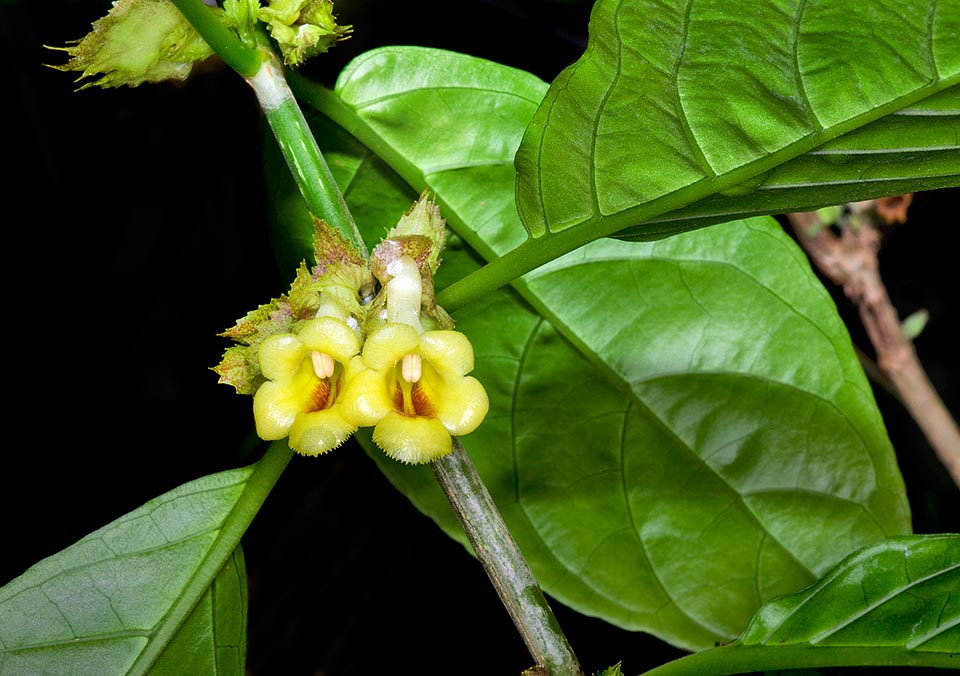Family : Gesneriaceae

Text © Pietro Puccio

English translation by Mario Beltramini
The species is native to Belize, Brazil (Acre), Colombia, Costa Rica, Ecuador, Guatemala, Mexico (Chiapas), Nicaragua, Panama, Peru and Venezuela where it lives in the humid forests from the sea level up to about 1000 m of altitude.
The name of the genus comes from the Greek “ δρυμόνιος” (drymónios) = living in the forests; the name of the species is the combination of the Greek adjective “μακρός” (macrόs) = great, long and of the substantive “φύλλον” (phyllon) = leaf, with obvious reference.
The Drymonia macrophylla (Oerst.) H.E.Moore (1955) is an epiphytic shrub, rarely terrestrial, 1,5-2 m tall, with young herbaceous angular stems of green colour, with smooth pale brown bark in the oldest part. The leaves, on a 1-5 cm long petiole, are opposite, simple, ovate to oblong-ovate with acuminate apex, slightly serrate margin and prominent veins below, 10-30 cm long and 5-12 cm broad, of intense green colour, at times suffused of purple below. Sessile axillar inflorescences, fasciculate, bearing few flowers, on short pedicel, with calyx with 5 unequal oblong-lanceolate lobes shortly united at the base, 1-2 cm long and about 0,5 cm broad, with mucronate apex and sinuate-toothed margins, of greenish colour, at times with dark red shades, to reddish. Imbutiform corolla white cream to pale yellow, slightly pubescent externally, reddish internally, with 2-4 cm long tube and 5 unequal lobes, rounded, 0,4-0,5 cm long, at times with minutely fimbriate margin, 4 didynamous stamens (two longer stamens and two shorter) and superior ovary. The fruits are globose capsules, of 1-2 cm of diameter, with persistent calyx, containing numerous seeds.

Little known species, native to tropical America, the Drymonia macrophylla is an epiphytic shrub, rarely terrestrial, 1,5-2 m tall © Giuseppe Mazza
It reproduces by seed, in porous and draining organic loam maintained humid at the temperature of 24-26 °C, but at amateur level recourse is done to the division of tufted plants and to cutting, in spring and early summer, in confined environment with bottom heat.
Little known species, present almost exclusively in botanical gardens and lovers’ collections, cultivable in open air in the tropical and humid subtropical climate regions in slightly shady position. Elsewhere is to be kept during the coldest months in a protected environment, luminous, with averagely high temperatures, 22-30 °C, with lowest winter night temperatures not under the 16 °C, and 60-80 % of humidity, placed in pots or baskets with very porous and draining compost, acidic or neutral, rich of organic substance. Scarcely suitable for interiors and terraria due to the size it may reach, unless not to do frequent pruning in order to maintain a contained and compact shape. The watering must be frequent during the vegetative period, but without stagnations that may easily cause rottenness, utilizing non calcareous water at ambient temperature, spaced in winter in order to allow the substratum to dry up almost completely. Monthly fertilizations in spring-summer utilizing a balanced hydro-soluble product with micro elements at half the dosage suggested on the package.
Synonyms: Caloplectus macrophyllus Oerst. (1858); Drymonia mucronulosa Hanst (1866); Alloplectus macrophyllus (Oerst.) Hemsl. (1882); Columnea macrophylla (Oerst.) Kuntze (1891); Drymonia ochroleuca Standl. (1936); Drymonia belizensis Standl. (1937); Drymonia rosea C.V.Morton (1942).
→ To appreciate the biodiversity within the GESNERIACEAE family please click here.
